Portal:Indonesia/Featured picture/2010
Featured Pictures of 2010[edit]
- Week 22

Braga Street, a main shopping street in Bandung. Street scene from the mid-1930s.
view -
talk -
history
- Week 23

The Suramadu Bridge, officially the Surabaya – Madura National Bridge, is three-section cable-stayed bridge connecting Surabaya, on the island of Java, and the town of Bangkalan, on the island of Madura. It is the longest bridge in Indonesia at 5,438 metres and is the first to cross the Madura Strait. Construction began in 2003 but was halted for nearly a year due to lack of funds. The bridge was opened to the public on 10 June 2009.
Photo credit: Sakurai Midori
view -
talk -
history
- Week 24

Megaria is the oldest cinema and largest remaining Art Deco building in Jakarta. One of its main tenants is the 21 Cineplex group, which operates the Megaria 21 movie theater. As a historic cinema, it screened films during the first Indonesian Film Festival (1955) and the 16th Asia Pacific Film Festival (1970). It was listed as an architectural heritage site by the city's governor in 1993.
view -
talk -
history
- Week 25

Two Sumatran Rhinoceroses (Dicerorhinus sumatrensis), Emi and her cub Harapan, in the Cincinnati Zoo and Botanical Garden, the only place in the world to successfully breed the critically endangered species in captivity. It is now estimated that fewer than 275 Sumatran Rhinoceroses remain in the wild due to illegal poaching and destruction of its rainforest habitat. Most remaining habitat is in inaccessible mountainous areas of Indonesia.
Photo credit: Charles W. Hardin
view -
talk -
history
- Week 26
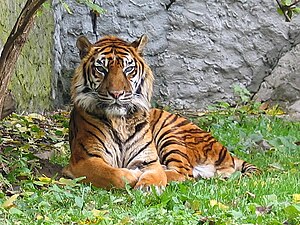
The Sumatran Tiger (Panthera tigris sumatrae) is the smallest of all surviving tiger subspecies. Currently, there are only 400-500 Sumatran tigers left in the wild. The largest population of about 110 tigers lives in Gunung Leuser National Park.
Photo credit: Monika Betley
view -
talk -
history
- Week 27

The Bromo Tengger Semeru National Park in East Java, comprises the caldera of the ancient Tengger volcano from which four new volcanic cones have emerged. This unique feature stretching over 5,250 hectares at an altitude of about 2,100 metres also contains the highest mountain in Java, Mount Semeru (3,676 m), four lakes and 50 rivers.
Photo credit: Jani Patokallio
view -
talk -
history
- Week 28

The Wasur National Park forms part of the largest wetland in Papua province and is recognised as being of international importance under the Ramsar Convention.
Photo credit: Standel
view -
talk -
history
- Week 29
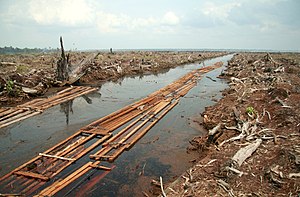
Extensive deforestation in Indonesia, as in this example from Sumatra, created massive environmental issues, and is a major contributor to Indonesia's greenhouse gas emissions. In May 2010 the government agreed to place a two-year moratorium on new logging concessions.
Photo credit: Aidenvironment
view -
talk -
history
- Week 30

The Wakatobi National Park is a marine national park, south of Sulawesi. The name of Wakatobi is an acronym of the four main Tukangbesi Islands: Wangi-wangi, Kaledupa, Tomia, and Binongko.
Photo credit: Jenny Huang
view -
talk -
history
- Week 31

Mt. Barujari and Segara Anak Lake in the Gunung Rinjani National Park, Lombok.
Photo credit: Midori
view -
talk -
history
- Week 32

The Gedung Merdeka, (formerly the Sociëteit Concordia building) on Braga Street in Bandung, where the Asian–African Conference was held in 1955, designed by Wolff Schoemaker. In 1922, Schoemaker became professor of the Technische Hoogeschool Bandoeng where he mentored Sukarno, who would become the first President of the Republic of Indonesia.
- Week 33

Sukarno reads the Proclamation of Indonesian Independence on the morning of 17 August 1945, unilaterally declaring the independence of Indonesia from the Netherlands. The event was triggered by Japan's surrender to Allied Forces two days earlier, ending World War II. Dutch forces returned to the region the following year in a fight to regain control of the archipelago before finally recognizing the nation's independence in 1949.
Photo credit: Frans Mendur
view -
talk -
history
- Week 34
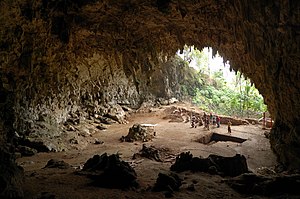
Partial skeletal specimens of Homo floresiensis were discovered in Liang Bua, a limestone cave on the island of Flores, by a joint Australian–Indonesian team of archaeologists in 2003 looking for evidence of the original human migration of H. sapiens from Asia to Australia. It is the only location in which such remains have been identified.
Photo credit: Rosa Cabecinhas & Alcino Cunha
view -
talk -
history
- Week 35

Becak were considered an icon of the capital city of Jakarta prior to its ban in the 1970s. Citing concerns of public order, the city government forbade them on the city's main streets. However, many becak still operate in slums throughout the city. Attempts at reinforcing the ban resulted in large-scale seizures of the vehicle in the late 1990s and in 2007.
Photo credit: Jonathan McIntosh
view -
talk -
history
- Week 36

Glaciers on Puncak Jaya include the Carstensz Glacier and the Northwall Firn. Since the 1970s, evidence from satellite imagery indicates the Puncak Jaya glaciers have been retreating rapidly. The Meren Glacier melted away sometime between 1994 and 2000. An expedition led by paleoclimatologist Lonnie Thompson in 2010 found that the glaciers are receding at a rate of seven meters per year and will disappear in four to five years.
Image credit: Sémhur
view -
talk -
history
- Week 37
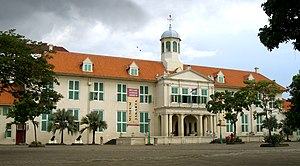
The former town hall of Batavia, in Jakarta Old Town, today houses the Jakarta History Museum (Museum Sejarah Jakarta).
Photo credit: Gunkarta
view -
talk -
history
- Week 38

Candi Plaosan, also known as Plaosan Complex, is one of the Buddhist temples located in Bugisan village, Central Java. The temple complex consists of 116 stupas and 58 shrines, built in the 9th century.
Photo credit: Gunkarta
view -
talk -
history
- Week 39

Jakarta Kota Station, inaugurated in 1929, it was designed by the architect Frans Johan Louwrens Ghijsels in Art Deco style.
view -
talk -
history
- Week 40

The Pasar Johar in Semarang, designed by Thomas Karsten (1884–1945). Karsten designed markets also in Surakarta and Yogyakarta, but is best known for his involvemenet in planning of numerous cities, including Bandung, Bogor, and Malang.
Photo credit: Atelier O. Hisgen & Co. (1938-42)
view -
talk -
history
- Week 41

Aerial photograph of Ikada Stadium during the opening ceremonies of the 1951 Pekan Olahraga Nasional (National Games) in central Jakarta. The stadium was eventually replaced by the Bung Karno Stadium as the city's main stadium. It was demolished following the 1962 Asian Games to make way for construction of the National Monument.
view -
talk -
history
- Week 42

Image by Danish photographer Kristen Feilberg taken around 1870 of a Batak Village in Langkat, North Sumatra.
Photo credit: Kristen Feilberg
view -
talk -
history
- Week 43

Balinese dancer I Mario, photographed in 1940.
view -
talk -
history
- Week 44
Surabaya, Indonesia's second largest city, derives its name from the Javanese words sura or suro (shark) and baya or boyo (crocodile). According to local mythology, a giant white shark and a giant white crocodile fight each other in order to gain the title of the strongest and most powerful animal in the area. The fight is depicted in the city's emblem.
Photo credit: Sakurai Midori
view -
talk -
history
- Week 45

A Peacock mantis shrimp pictured near Manado.
Photo credit: Jens Petersen
view -
talk -
history
- Week 46

Tesso Nilo National Park in Sumatra, is one of the last remaining habitats of the endangered Sumatran Elephant.
Photo credit: A. C. Shapiro
view -
talk -
history
- Week 47

Wild Deers near Bama Point in Baluran National Park, East Java.
Photo credit: rochmad setyadi
view -
talk -
history
- Week 48

The Danau Lindu lake in Lore Lindu National Park, central Sulawesi, is part of the UNESCO World Network of Biosphere Reserves.
Photo credit: Aidenvironment
view -
talk -
history
- Week 49

Bantengs in Alas Purwo National Park, East Java.
Photo credit: Rochmad Setyadi
view -
talk -
history
- Week 50

Mangroves in West Bali National Park, located on the north western side of Bali.
Photo credit: Ronrad
view -
talk -
history
- Week 51

A village near the coast of Sumatra lies in ruin in the aftermath of the 2004 Indian Ocean earthquake. Earthquakes triggered by subduction of tectonic plates caused tsunamis throughout the Indian Ocean. Indonesia was the hardest hit nation, with an estimated 220,000 deaths from the disaster.
Photo credit: Philip A. McDaniel, U.S. Navy
view -
talk -
history
- Week 52
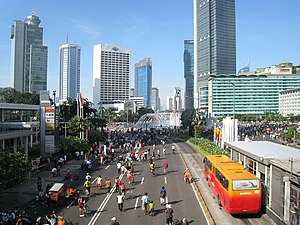
Car-Free Days are organised in Jakarta on the last Sunday of every month, by closing the traffic from 6am to 12am on sections of Thamrin and Sudirman avenues. The TransJakarta Bus Rapid Transit system is still operating.
Photo credit: Gunawan Kartapranata
view -
talk -
history
